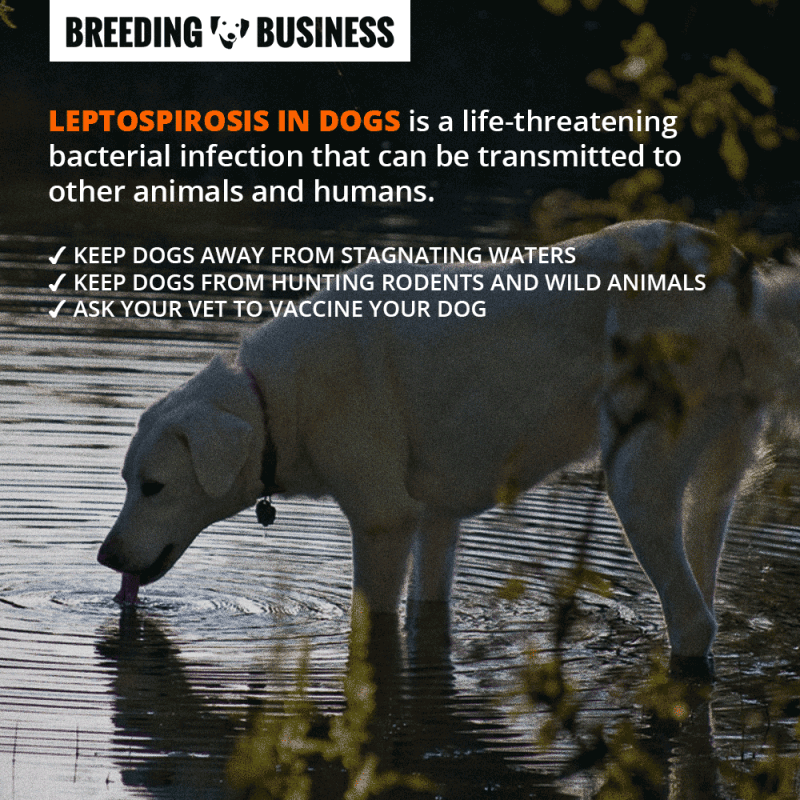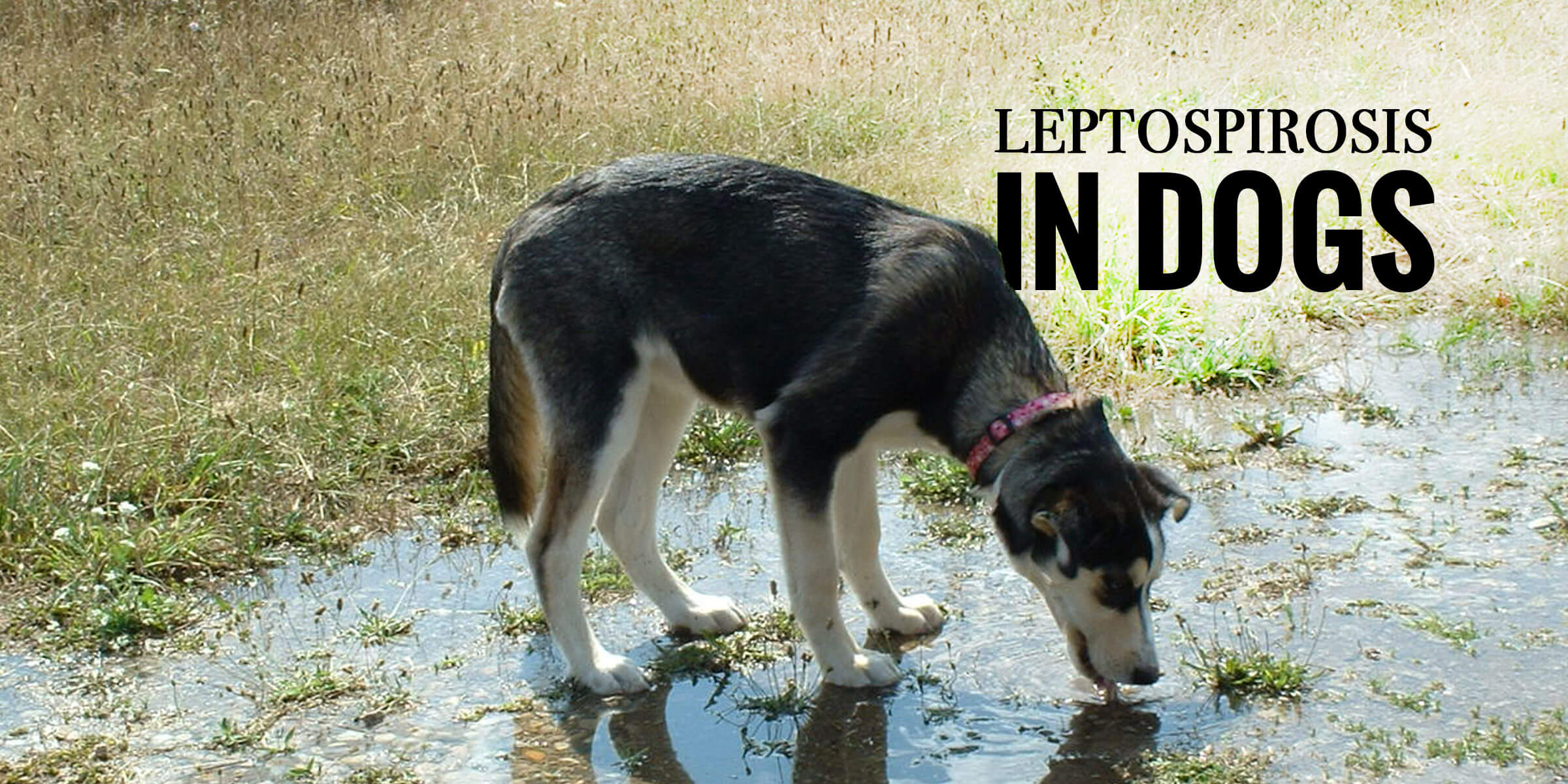Leptospirosis is a dangerous bacterial infection that can be transmitted to other animals, including humans. As a dog owner, it’s crucial to be aware of the risks and take necessary precautions to protect your pet’s health.
While keeping your dog’s immune system healthy is vital, it’s not a foolproof method for eradicating the threat of leptospirosis. To ensure your dog’s safety, it’s crucial to practice good hygiene, avoid contaminated water sources, and get your pet vaccinated against the disease.
What is Leptospirosis in Dogs
Leptospirosis is a life-threatening bacterial infection commonly affecting dogs caused by the bacterium Leptospira. This bacterium is coming in various strains called serovars. Of these, mainly four can contaminate domestic dogs:
- Leptospira canicola — dogs
- Leptospira grippotyphosa — opossums, skunks, raccoons, squirrels, and small rodents
- Leptospira icterohaemorrhagiae — pigs and rats
- Leptospira pomona — pigs, cattle, deers, raccoons, and skunks
Furthermore, it is important to be aware that leptospirosis is a zoonotic infection, meaning the condition can spread from infected animals to humans. Apart from dogs and humans, this bacteria is also known to infect cats, although to a lesser degree. Wild animals including opossums, skunks, and raccoons may also get it. Livestock is also sometimes infected. The leptospira bacteria usually dwell in the kidney and start to reproduce from within.

Symptoms of Leptospirosis in Dogs
The symptoms of leptospirosis can take up to 12 days to manifest. If you suspect that your dog has contracted the infection, look out for symptoms like:
- muscle pain and stiffness
- depression and tiredness,
- vomiting,
- fever,
- general weakness,
- decreased appetite,
- eye inflammation (uveitis)
- and dehydration.
Other indications of the condition may be conjunctivitis, jaundice, hemolytic anemia, coughing, diarrhea, and difficulty breathing.
While all of these symptoms are worrisome, the worst symptom is kidney failure, occurring with or without liver failure. Speckled gums with a dark red color and swollen mucous membrane are some more symptoms of the disease. In the case of bitches, there could be a bloody vaginal fluid discharge which can also point to a leptospirosis infection.
Sometimes, there might not be any visible symptoms of illness at all, as the infection may also be asymptomatic. But if you do find any of the mentioned symptoms, it would be a good idea to get your dog checked by a veterinarian, at least for peace of mind.
Causes of Leptospirosis in Dogs
Leptospirosis is an infection caused by closely related bacteria belonging to the Leptospira genus. These bacteria can be found all over the world in soil and water, especially in regions with warm climates and high rainfall.
Dogs can get infected by drinking contaminated water, particularly from stagnant water sources like ponds. They can also contract the infection by coming into direct contact with an infected animal or its urine, or by consuming meat contaminated with leptospira. Once infected, an animal can continue to be a source of the bacteria for months or even years, as long as it can survive.
Veterinarians typically see a surge in leptospirosis infections from July through December each year. This is partly due to an increase in small rodents, rats, skunks, and raccoons in both urban and rural areas. This puts dogs at a higher risk of contracting one of the Leptospira serovars.
How is Leptospirosis Diagnosed for Dogs?
When you take your pet to the vet, they may check whether your dog has been vaccinated against leptospirosis. They may also ask you questions about any exposure to the bacteria and if your pet has a history of any illnesses. A complete physical examination may also be performed to gather more relevant clinical information.
Leptospirosis infection is usually diagnosed by testing urine samples or by checking for an increasing amount of antibodies to leptospira. This exhibits an active immune reaction in a test called the microscopic agglutination test (MAT).
How to Prevent Leptospirosis in Dogs
As a potentially lethal bacterial infection, dog owners want to know the best ways to prevent leptospirosis in dogs. So then, your dog’s immune system builds the adequate defense mechanisms that will be able to fight and eradicate a Leptospirosis strain the day it is encountered.
Leptospirosis vaccine
You can vaccinate your dog against leptospirosis. But one downside of vaccination is that there are many strains of leptospira bacteria and only a few vaccines against some of them. Nevertheless, these are still useful to keep the bacteria at bay, and most veterinarians recommend vaccination for dogs that run the risk of exposure, like those living in relatively unhygienic locations.
Vaccines are, however, contraindicated for dogs that are sick, pregnant, nursing, already infected, or have weak immunity. Make sure to consult your vet before you decide to vaccinate your pet.
Side effects of the vaccine
Ironically, the vaccine for leptospirosis can also cause some unwanted and potentially discomforting side effects. These include lethargy and loss of appetite. Some dogs may start to develop skin rashes on certain parts of their body.
Toy breeds tend to go into anaphylactic shock after the administration of these vaccines. You can gather whether they are going into a shock by symptoms like diarrhea, vomiting, frequent urination, excessive salivation, increased heart rate, and seizures. The dog may even go into a coma as a result of the vaccine.
Dogs Naturally Magazine, an online blog known for dismissing regular veterinary behaviors, went as far as saying the leptospirosis vaccine was not effective. This is a stretch I wouldn’t personally make.
Taking care of some environmental factors
If you live in an area with greater chances that your dog might get infected, such as areas with considerable wildlife or dirty stagnating water reservoirs, prevent the dog from venturing out on its own and smelling rats.
Never let your pets swim in or drink from ponds or slow-moving rivers, or any other body of stagnant water. Keep it from hunting rodents and other wild animals, which are also carriers of the bacteria. If you take your dog out to the park for a stroll, make sure to never let it out of your sight.
How to avoid getting affected yourself?
It’s important to be very careful when handling an infected dog, as you can also become infected. Leptospirosis is a serious infection caused by a type of bacteria called Leptospira. The infection can be dangerous for both you and your dog, so always wear gloves and wash your hands well after handling them. Keep your infected dog away from kids, older people, and pregnant or nursing women.
Even if your dog appears to have recovered, it may still have the bacteria in its urine. Be cautious for a few days to make sure they’re really better.
To make sure all of your pets are safe, check and treat any other pets in your home. Keep them separated until you’re sure the infected pet is completely healthy.
Leptospirosis Treatment for Dogs
[adwithin]
If your dog is severely infected, it must be taken to the hospital where it will be given fluids through a drip to prevent dehydration. If your dog is bleeding internally, it might need a blood transfusion, which can be expensive. Therefore, it’s important to have a good dog insurance plan to help with the vet bills.
Remember, the earlier the treatment starts, the higher the chances of survival. The usual method is by giving antibiotics. If the infection is diagnosed early enough, the preferred antibiotics are penicillin or doxycycline. However, if the infection has reached the carrier stage, stronger antibiotics such as tetracyclines and fluoroquinolones will be necessary.
The prescription period will last for at least four weeks. It’s important to know that these are strong antibiotics, and they might have side effects that are just as severe as the infection. Talk to your vet and read the medicine label to learn about possible side effects.
Take-away Points
In summary, Leptospira is the bacterium causing the infection, and it comes in several strains. Some of which are found in dirty waters, while others favor small rodents as hosts.
The available vaccine offers good protection against some of these strains, but not all of them. Therefore, as the dog owner, you still need to keep your dog away from stagnating dirty waters and woods, especially in areas notoriously known for their high level of leptospirosis infections. The bacteria like warm and humid climates, and is at their peak in the United States from June and July onwards.
Leptospirosis in dogs is a potentially life-threatening infection transmitted by one of the dozen of strains of the bacterium Leptospira.
